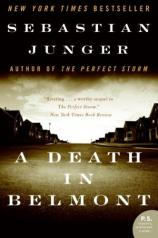A Death in Belmont
Review
A Death in Belmont
Sebastian Junger has a good reporter's affinity for disasters of
various sorts. He has reported for years from the world's hot spots
--- wars, riots, revolutions --- and his two best-known books dig
deeply into the roots of disasters of a more personal kind. THE
PERFECT STORM told of the loss at sea of a Massachusetts fishing
boat. A DEATH IN BELMONT reopens in great detail the case of the
Boston Strangler murders of the early 1960s. It is mainly concerned
with one of the murders, the March 1963 killing of Bessie Goldberg,
an elderly housewife in the pleasant Boston suburb of
Belmont.
Junger is an incredibly thorough researcher and a careful writer.
His basic conclusion: Since the two prime suspects in Bessie
Goldberg's murder are long dead, the murderer's identity --- and by
extension the positive identity of the Boston Strangler --- can
never be known for certain. Junger even considers the remote
possibility that the Goldberg murder was committed by someone who
was not the Strangler.
Junger has a chilling personal reason for involving himself in this
case. In his infancy his mother had added a studio to their Belmont
home in furtherance of her ambitions as a painter --- and one of
the work crew on that job was Albert DeSalvo, who later created a
sensation by confessing to being the Boston Strangler. Junger tells
of an incident related by his mother: Once, at the height of public
anxiety over the Strangler murders, DeSalvo tried to lure her into
the basement of their home on a pretext, but she, frightened by his
strange demeanor, stayed upstairs. Junger wonders aloud what might
have happened to her had she descended those stairs.
This book is the work of a reporter turned serious author, and that
is both a virtue and a defect. Junger sees everything, travels
everywhere and interviews everyone he could find who had the
remotest connection with the Goldberg case or the Strangler
murders. His legal research is enlightening, his conclusions drawn
from it fair. But the level of detail sometimes gets in the way of
Junger's narrative. We get detailed descriptions of each building
that figures in his story, lengthy asides about the Kennedy
assassination (which took place during the trial of the main
suspect, Roy Smith) and the war-related unrest of the 1960s, a
potted history of Belmont itself, many digressive asides about
other serial murder cases --- in general a great deal of
information that, while often interesting, is not terribly germane
to the story.
Suspect Roy Smith, who was arrested for the Goldberg murder, tried,
convicted and sentenced to life in prison, joins DeSalvo as the
main tragic figure in this sordid story. Both men had horrific
childhoods, lives of aimless drifting and crime, and an inability
to better those lives. Smith, an Afro-American, had been
emotionally scarred forever by the brutal racism of his native
Mississippi. His very presence in Belmont on the day of the
Goldberg murder made him a marked man --- a black walking the
streets of a lily-white upper-class Boston suburb (he had been sent
by a state agency to do cleaning work at the Goldberg home).
DeSalvo was tortured by inner sexual compulsions that even he could
not understand. He first confessed to being the Boston Strangler,
then later denied it. He seems to have been a mystery even to
himself.
The lives of both men ended tragically. Smith died just as a
groundswell of belief in his innocence was gaining strength. He
died in a hospital, still protesting his innocence and with a
long-sought commutation of his sentence lying on a bedside table.
DeSalvo was himself brutally murdered in prison, stabbed 16 times
by someone who had gotten to his cell through four locked
doors.
Junger's final verdict seems to be that Smith was probably innocent
and that DeSalvo seems to fit the profile of someone who could have
committed the Goldberg murder as well as the 13 other Strangler
murders. But Junger is too careful a writer to make any direct
accusations.
This is a sordid story, full of gruesome detail that might offend
some readers. But it is a tale well told, and it raises issues
that, like the Boston Strangler murders themselves, have never
really gone away.
Reviewed by Robert Finn (Robertfinn@aol.com) on December 29, 2010
A Death in Belmont
- Publication Date: April 1, 2007
- Genres: Nonfiction, True Crime
- Paperback: 266 pages
- Publisher: Harper Perennial
- ISBN-10: 0060742690
- ISBN-13: 9780060742690





